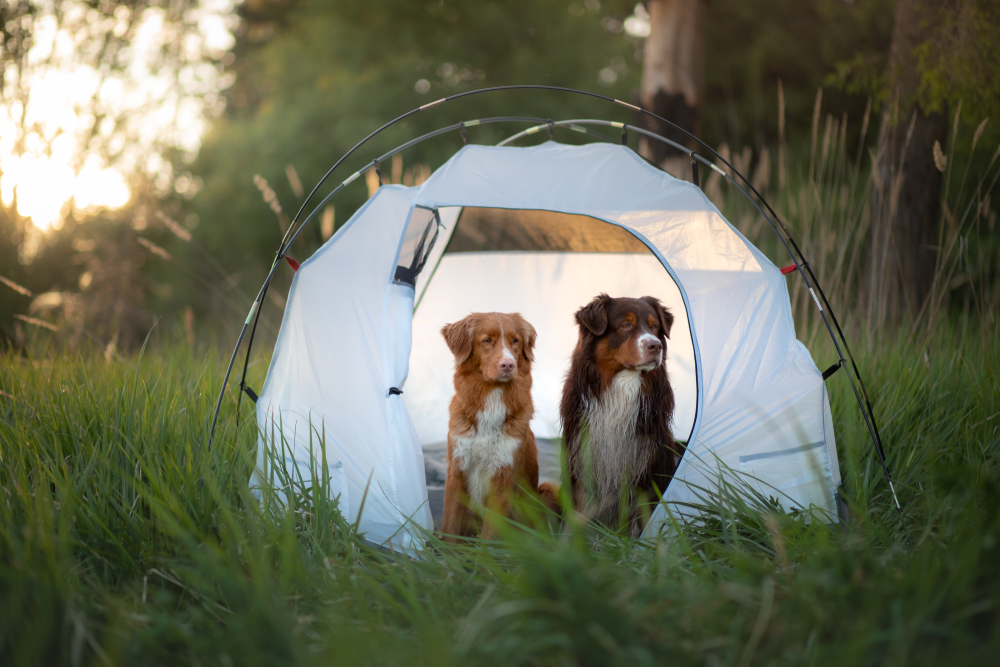5 Tips To Keep Your Dog Safe While Hiking and Camping

If you have the camping and hiking bug, you probably own a dog who is equally as excited about spending time outdoors. You don’t want to leave your pet at home when striking out on one of these adventures, so plan ahead to ensure they can come with you and be safe. Our team at Bayside Animal Hospital has a list of hiking and camping safety tips that can help.
#1: Ensure that your dog is protected, healthy, and fit enough for the trip
Before heading out on the trail, ensure your pet is up for the exertion and prepared for what is ahead.
- If your pet’s exercise regimen consists of a leisurely walk around the block twice a day, they likely will not be able to handle a 10-mile hike up a steep incline. Carefully consider your pet’s fitness level before taking them on an advanced trail.
- If your pet is older, they may have issues, such as arthritis, that could make extensive walking over difficult terrain too demanding.
- Be aware of weather conditions. Brachycephalic dogs, such as bulldogs and pugs, are prone to respiratory problems, especially during warmer weather. Any dog can become overheated on a hot day and should be monitored for signs indicating heat exhaustion.
- Your pet should be up to date on vaccinations, especially rabies, distemper, leptospirosis, and Lyme disease.
- Ensure that your pet is on a comprehensive flea and tick prevention program as well as a heartworm preventive. Fleas, ticks, and mosquitoes abound in most camping and hiking spots, and you want your pet to be protected from these parasites and the diseases they carry.
#2: Check for any pet regulations
You should be respectful by following the location’s rules. Take the time to research what regulations they have since not following the rules could result in a hefty fine.
- Some campgrounds and hiking areas do not allow dogs on trails.
- Some sites allow dogs but require a permit. Check beforehand to ensure you have all the documentation required.
- Most locations mandate leashes be used at all times, but you can check the specific area to see their particular leash laws.
#3: Follow appropriate pet etiquette while on trails
Follow hiking etiquette guidelines to ensure you and your dog do not annoy your fellow hikers.
- Keep your dog with you, preferably leashed, and under your command at all times.
- Allow only one dog per person and no more than two dogs per group, regardless of how many people are in the group.
- Greet any oncoming hikers with a genial tone to indicate to your dog that they are a friend.
- Step off the trail with your dog to give hikers without dogs the ability to pass.
- Provide appropriate training before your trip to ensure your dog will not be aggressive toward other dogs or people.
- Do not allow your dog to approach other hikers.
- Bag your pet’s waste or bury it at least 6 inches deep and 200 feet from water sources.
- Ensure your dog does not disturb or harm wild animals or plant life.
#4: Know what supplies to bring for your dog
Be prepared with the appropriate supplies to ensure a pleasant trip.
- Water with water bowl (one quart per dog for every three miles)
- Nutritionally dense dog food and snacks
- Short, flat leash. Do not use retractable leashes when hiking or camping.
- Well fitted collar with accurate identification
- Pet first aid kit
- Plastic baggies for removing dog waste
#5: Keep your dog safe from wildlife and natural elements
Wild animals can injure or kill your pet if they feel their food source is threatened. Also, the terrain in nature can be dangerous if precautions are not taken.
- Keep your food supply and trash in sealed containers in your vehicle.
- Be aware of your dog’s proximity to cliffs. You do not want them to accidentally fall if they run ahead and do not realize there is a dropoff.
- Your dog is susceptible to contracting a waterborne illness if they drink from a natural water source. You likely will not be able to prevent them from diving in on a hot, sweaty day, but at least try to lead them toward clear, running water. Provide them with bottled water frequently during the day to keep their intake of natural water to a minimum.
Now you have all the information you need to have an enjoyable, safe outdoor adventure with your dog. Before heading out, contact Bayside Animal Hospital for a thorough evaluation to ensure your pet is ready for their next adventure.


